
Italian traffic signs guide drivers through roads safely, ensuring clear communication. The official PDF guide covers designs, regulations, and meanings, essential for navigating Italy’s roads. Unique signs, like the red truck indicator, highlight specific restrictions, while right-of-way signs, such as yellow diamonds, prioritize traffic flow. Understanding these signs is crucial for safe and compliant driving in Italy.
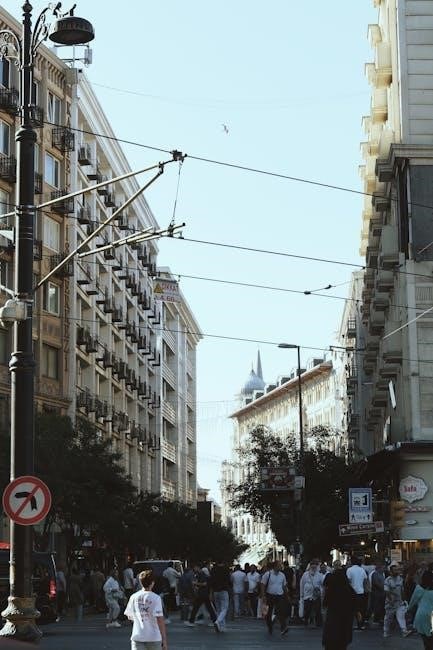
Categories of Traffic Signs
Italian traffic signs are categorized into warning, regulatory, and informational. Warning signs indicate hazards like roundabouts and bends. Regulatory signs enforce rules such as right-of-way and speed limits. Informational signs provide directions and services.
2.1 Warning Signs
Warning signs in Italy are designed to alert drivers to potential hazards or changes in road conditions. These signs are typically triangular with a yellow background and a red border, ensuring high visibility. Common examples include the roundabout ahead sign, which features a circular arrow diagram, and bend signs indicating turns to the right or left. Double bend signs warn of two consecutive curves, first to the right or left. These signs are crucial for preparing drivers for upcoming road features, reducing the risk of accidents. Additionally, some warning signs incorporate unique elements, such as the red truck indicator, which signals restrictions for large vehicles. By understanding these signs, drivers can navigate Italian roads more safely and confidently. These visual cues play a vital role in maintaining traffic flow and road safety across Italy.
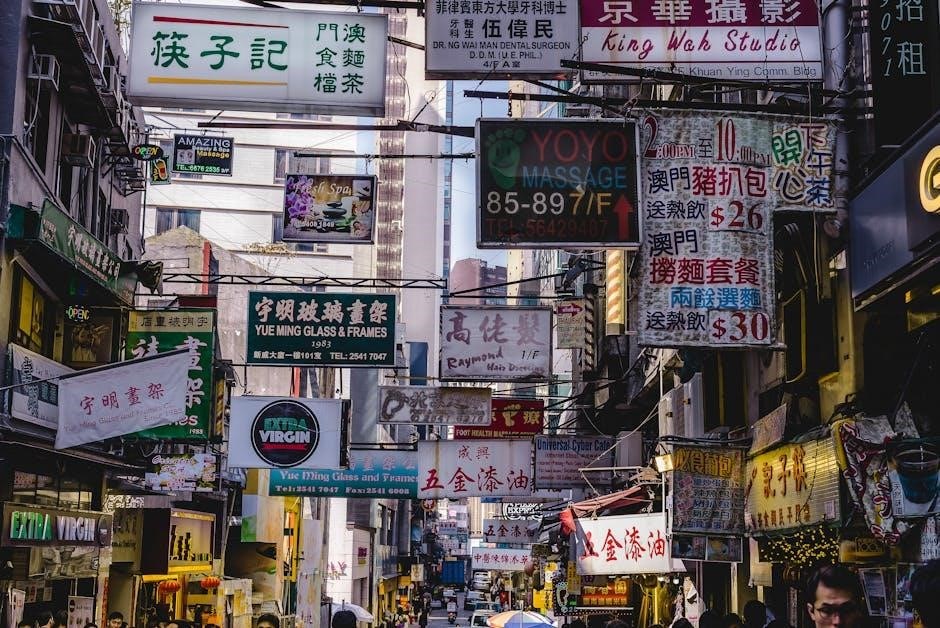
2.1.1 Roundabout Ahead
The “Roundabout Ahead” sign in Italy is a triangular warning sign with a yellow background and red border. It features a stylized image of a circular intersection, indicating an upcoming roundabout. This sign alerts drivers to prepare for a traffic circle, where vehicles merge and circulate counterclockwise. The design ensures visibility from a distance, helping drivers adjust speed and position. Roundabouts are common in Italy, and this sign is essential for safe navigation, especially for unfamiliar drivers. It emphasizes the need to yield to traffic already in the roundabout and signals the approach to a junction requiring careful attention. Understanding this sign is crucial for smooth traffic flow and accident prevention at roundabout intersections.
2.1.2 Bend to Right
The “Bend to Right” sign in Italy is a triangular warning sign with a yellow background and red border. It features a stylized image of a curved arrow pointing to the right, indicating an upcoming right-hand bend in the road. This sign alerts drivers to a change in road direction, allowing them to adjust their speed and position. The bend may be sharp or gradual, but the sign serves as a critical warning to ensure safe navigation. It is often accompanied by additional information, such as advisory speed limits or road markings, to further guide drivers. Recognizing this sign is essential for maintaining control of the vehicle, especially on winding roads or in areas with reduced visibility. It is a key component of Italy’s traffic signage system, designed to enhance road safety and driver awareness.
2.1.3 Bend to Left
The “Bend to Left” sign in Italy is a triangular warning sign with a yellow background and red border. It features a stylized image of a curved arrow pointing to the left, indicating an upcoming left-hand bend in the road. This sign alerts drivers to a change in road direction, allowing them to adjust their speed and position. The bend may be sharp or gradual, but the sign serves as a critical warning to ensure safe navigation. It is often accompanied by additional information, such as advisory speed limits or road markings, to further guide drivers. Recognizing this sign is essential for maintaining control of the vehicle, especially on winding roads or in areas with reduced visibility. It is a key component of Italy’s traffic signage system, designed to enhance road safety and driver awareness.
2.1.4 Double Bend
The “Double Bend” sign is a triangular warning sign used in Italy to indicate two consecutive bends in the road, one after the other. The sign features a stylized image of two curved arrows, one above the other, pointing in the same or alternate directions. This sign alerts drivers to a section of road where the direction will change twice, requiring careful navigation. It is commonly placed in mountainous or hilly regions where the road layout is particularly winding. The double bend sign is crucial for road safety, as it gives drivers advance notice to reduce speed and stay alert. The arrows’ orientation may vary, indicating whether the bends are to the left, right, or alternating directions. Recognizing this sign helps drivers anticipate the road’s layout and adjust their driving accordingly, ensuring safer passage through challenging terrain.
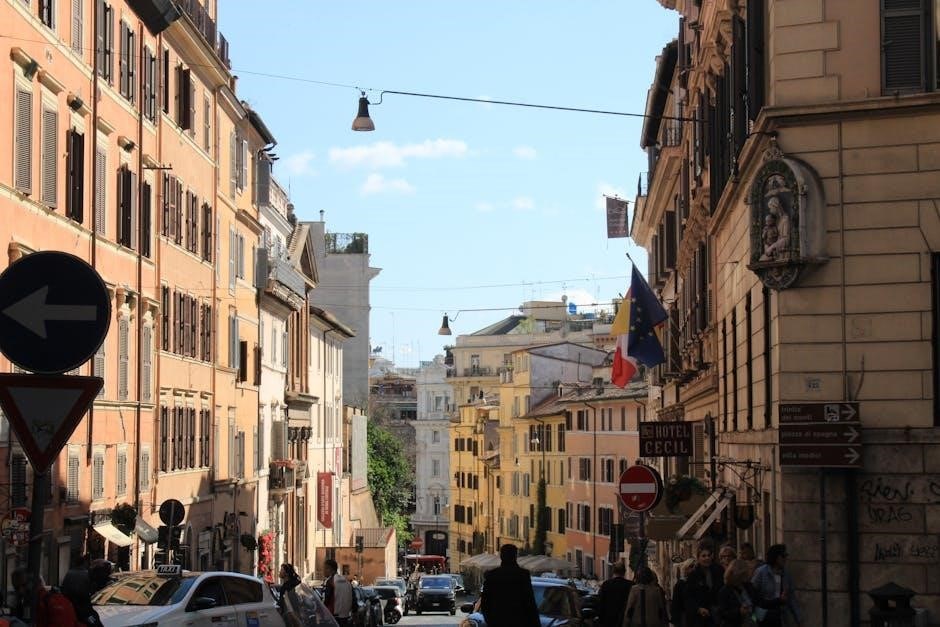
2.2 Regulatory Signs
Regulatory signs in Italy are designed to convey specific rules and laws that drivers must follow. These signs are typically rectangular or circular in shape and often feature clear, bold symbols or text. They are used to regulate traffic flow, enforce speed limits, and indicate right-of-way priorities. Common examples include speed limit signs, stop signs, and right-of-way signs. Regulatory signs are essential for maintaining order on the roads and ensuring compliance with Italian traffic laws. They are often accompanied by supplementary plates to provide additional information. These signs are standardized across the country to ensure consistency and clarity for all drivers. By adhering to the instructions provided by regulatory signs, motorists can contribute to safer and more efficient road conditions. Understanding these signs is crucial for navigating Italian roads effectively and avoiding potential penalties.
2.2.1 Right-of-Way Signs
Right-of-way signs in Italy are used to indicate which vehicles or road users have priority at intersections or junctions. These signs are crucial for maintaining smooth traffic flow and preventing conflicts. Common examples include signs with an “X” symbol or chevron arrows, which indicate priority to traffic on the main road. Another key sign is the yellow diamond, which signals that drivers must yield to oncoming traffic. These signs are often placed at the approaches to intersections and roundabouts to guide drivers. They are accompanied by supplementary plates in some cases to clarify specific conditions. Right-of-way signs are standardized to ensure clarity and consistency across Italy. By following these signs, drivers can navigate intersections safely and efficiently. Understanding priority rules is essential for complying with Italian traffic laws and avoiding accidents.
2.2.1.1 Yellow Diamond Signs
The yellow diamond sign is a key right-of-way indicator in Italy, often used to alert drivers that they must yield to oncoming traffic. This triangular sign features a yellow background with a black border and a white interior, making it highly visible. It is commonly placed at intersections or junctions where priority is not automatically granted. The sign signals to drivers that they must slow down and be prepared to stop if necessary, ensuring smooth traffic flow. In some cases, supplementary plates are added below the sign to provide additional information, such as the distance to the intersection or specific lanes affected. Understanding the yellow diamond sign is crucial for safe navigation of Italian roads, as it directly impacts how drivers approach intersections and prioritize traffic. This sign is a fundamental part of Italy’s traffic regulation system.
2.2.1.2 End Right-of-Way Signs
In Italy, the end right-of-way sign indicates the termination of a priority zone, informing drivers that they no longer have the right-of-way. This sign is crucial for maintaining orderly traffic flow, especially after sections where priority has been granted. The sign features a white background with a diagonal black stripe, often accompanied by supplementary plates for clarity. It is typically placed at the end of a priority road or at intersections where the right-of-way changes. Drivers must adjust their behavior accordingly, yielding to other traffic when necessary. This sign ensures a smooth transition between priority and non-priority zones, reducing the risk of accidents. Understanding its meaning is essential for compliance with Italian traffic regulations and safe driving practices. The end right-of-way sign is a key component of Italy’s traffic management system, promoting efficient and safe road usage.
2.2.2 Stop Signs
In Italy, stop signs are a critical component of traffic regulation, ensuring safety at intersections and other critical points. The Italian stop sign, known as “Fermata” or “Stop,” is universally recognized due to its distinctive octagonal shape and red-and-white color scheme. Drivers encountering a stop sign must come to a complete halt before the white line painted on the road, yielding to all other traffic, including pedestrians and vehicles from other directions. These signs are often accompanied by supplementary plates indicating specific conditions, such as “Stop e Dare Precedenza” (Stop and Give Way). Failure to comply with stop signs can result in severe penalties, including fines and points deducted from the driver’s license. Adhering to stop signs is essential for maintaining order and preventing accidents in Italian traffic. They play a vital role in enforcing right-of-way rules and ensuring smooth traffic flow.
2.2.3 Speed Limit Signs
Speed limit signs in Italy are essential for maintaining order and safety on the roads. These signs are circular with a red border and a white background, displaying a number that indicates the maximum allowed speed in kilometers per hour. Common speed limits include 50 km/h in urban areas, 90-110 km/h on highways, and 100-130 km/h on motorways (autostrade). The signs are often accompanied by additional information, such as the start or end of a speed-restricted zone. Drivers must adhere to these limits, as exceeding them can result in fines and penalties. Speed limit signs are frequently placed at the entrance to towns, near schools, or in areas with high pedestrian activity. They play a crucial role in reducing accidents and ensuring smooth traffic flow across Italy’s diverse road network.
2.2.4 Priority to Vehicles

Priority to vehicles signs in Italy are designed to indicate which drivers have the right-of-way at intersections or road junctions. These signs are crucial for maintaining smooth traffic flow and preventing accidents. The most common priority sign is the “Priority Road” sign, which is a yellow diamond with a white interior and a black border. This sign signals that drivers on the road ahead have priority over vehicles joining from other directions. Another key sign is the “Yield” sign, represented by a white triangle with a red border pointing downward. This sign instructs drivers to slow down and give priority to oncoming traffic before proceeding. These signs are often placed at intersections where visibility is limited or where traffic merges. Ignoring priority signs can lead to severe penalties, emphasizing their importance in Italian road safety regulations.
2.3 Informational Signs
Informational signs in Italy are designed to provide drivers with essential information to navigate the road network efficiently. These signs help motorists make informed decisions about their journey. One common type is the directional sign, which indicates the names of towns, cities, or landmarks. They often feature arrows pointing to the direction of the destination. Another type is the service sign, which highlights nearby amenities such as restaurants, rest areas, or gas stations. These signs are typically blue or green and include pictograms for easy recognition. Additionally, informational signs may indicate road conditions, tourist attractions, or alternative routes. They are strategically placed to ensure drivers can plan their journey without confusion. By providing clear and concise information, these signs play a vital role in enhancing the driving experience in Italy.
2.3.1 Directions
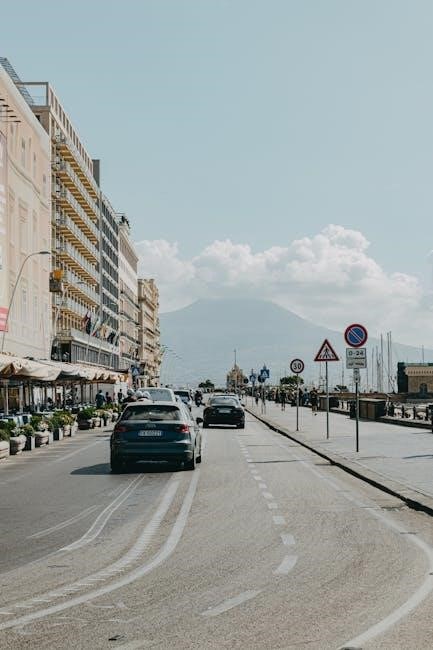
Directional signs in Italy are essential for guiding drivers through the country’s extensive road network. These signs are typically rectangular with a green or blue background, depending on the type of road. They display the names of cities, towns, or landmarks, often accompanied by arrows indicating the direction of travel. Motorway signs are usually green, while other roads are marked with blue signs. These signs are placed at intersections, roundabouts, and key decision points to help motorists navigate efficiently. They often include distances to destinations, ensuring drivers can plan their routes accordingly. Directional signs are designed to be clear and easy to read, reducing confusion and helping drivers reach their destinations without delay. They are a critical component of Italy’s traffic sign system, supporting safe and efficient travel across the country.
2.3.2 Services
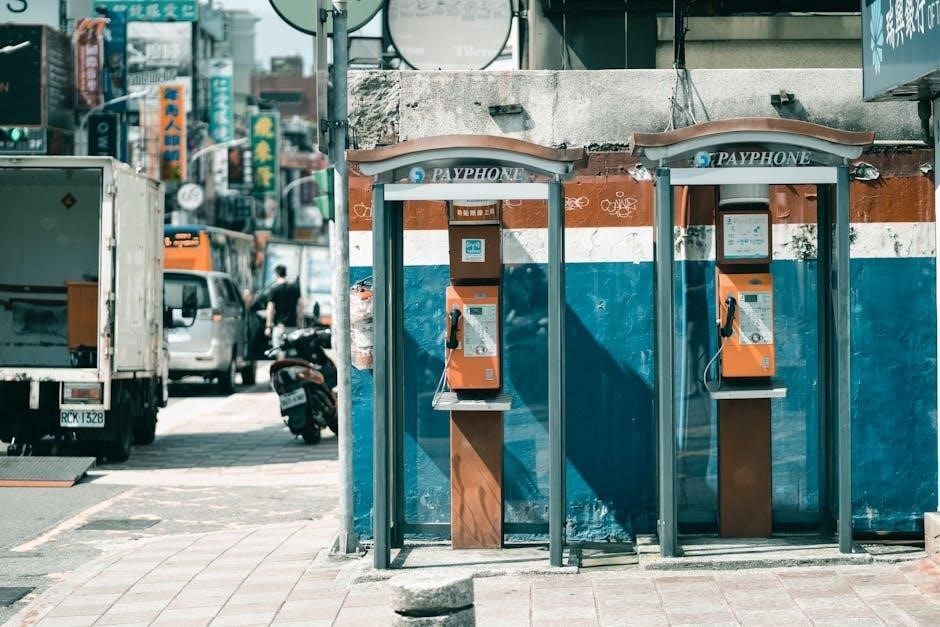
Service signs in Italy are designed to provide motorists with essential information about nearby facilities and amenities. These signs are typically rectangular, with a blue background and white text or symbols. They indicate the location of services such as parking areas, restaurants, hotels, rest areas, and emergency services like hospitals or SOS points. Service signs are strategically placed near exits, intersections, or along highways to help drivers plan their stops. They often feature universally recognized symbols to ensure clarity for all road users, including international drivers. These signs play a crucial role in enhancing convenience and safety on the road, allowing drivers to find necessary services without distractions. By guiding motorists to rest areas and amenities, service signs help reduce driver fatigue and contribute to a smoother journey across Italy.
Common Regulatory Signs
Regulatory signs enforce traffic laws and manage flow. They include prohibitory signs, like ‘No Entry,’ and mandatory signs, like ‘Turn Right Ahead,’ ensuring safe and orderly movement.
3.1 Prohibitory Signs
Prohibitory signs in Italy indicate actions that are not allowed. Examples include “Divieto di Accesso” (No Entry), “Divieto di Sosta” (No Parking), and “Precedenza ai Veicoli” (Priority to Vehicles). These signs are crucial for maintaining order and safety on the roads. They are typically circular with a red border and a white or blue background. “No Entry” signs feature a red “X” inside the circle, while “No Parking” signs display a “P” with a diagonal line through it. These signs are placed strategically to alert drivers of restrictions ahead, ensuring compliance with traffic laws. Understanding these signs is essential for drivers to avoid violations and navigate roads safely. They are standardized across Italy, making them easily recognizable for both locals and tourists.
3.2 Mandatory Signs
Mandatory signs in Italy indicate actions that drivers must follow. These signs are circular with a blue background and white symbols. Common examples include “Preavvisi di Direzione” (Advance Direction Signs) and “Obbligo di Direzione” (Direction Obligation Signs). These signs guide drivers through turns, merges, or straight paths. For instance, a blue sign with an arrow pointing straight ahead indicates that drivers must continue straight. Others may feature arrows directing traffic to turn left or right. These signs are essential for maintaining traffic flow and ensuring safety. They are often placed before intersections or roundabouts to guide drivers. Understanding mandatory signs is crucial for compliant and safe driving in Italy. They help reduce confusion and ensure smooth navigation through complex road layouts.
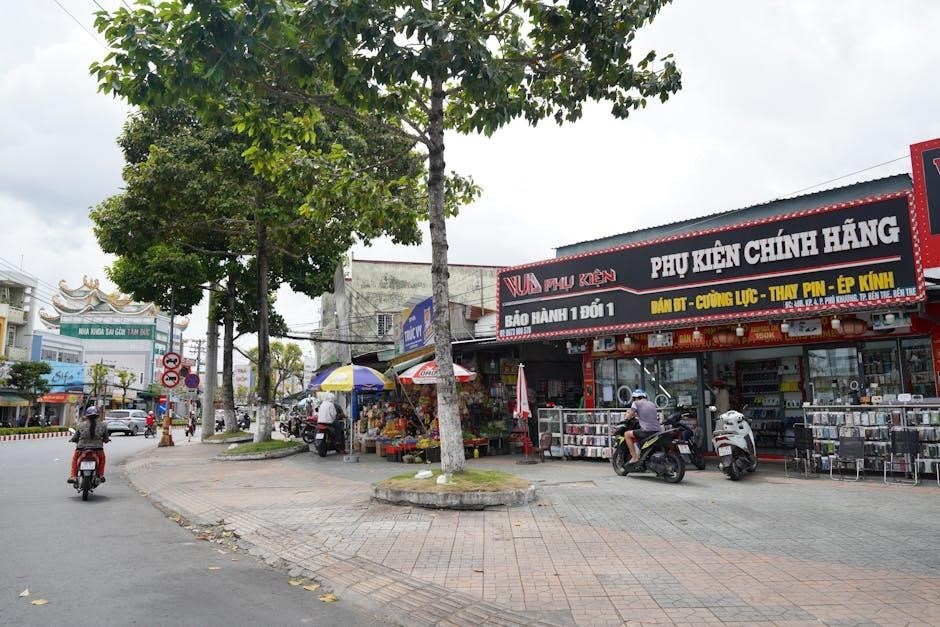
Traffic Lights and Pedestrian Crossings
Traffic lights in Italy are standardized, following the typical green, yellow, and red sequence. They are essential for regulating the flow of vehicles and pedestrians at intersections. Many traffic lights in urban areas now include countdown timers, indicating how many seconds remain before the light changes. Pedestrian crossings, known as attraversamenti pedonali, are marked by white stripes on the road and are often accompanied by traffic lights or zebra crossings. In some cases, audible signals assist visually impaired pedestrians. Italy also uses advanced systems, such as intelligent traffic lights that adapt to traffic conditions. These systems help reduce congestion and improve safety. Understanding traffic lights and pedestrian crossings is vital for safe navigation of Italian roads. They play a key role in maintaining order and ensuring the safety of all road users.
Resources for Download
The Italian Traffic Signs PDF is available for download on official government websites. It includes high-resolution images and detailed explanations of all road signs, ensuring clarity and understanding for drivers.
5.1 Where to Find the PDF
The Italian Traffic Signs PDF can be downloaded from official government sources, such as the Ministry of Infrastructure and Transport website or regional transport authorities. These resources are often free and easily accessible. Additionally, the Italian Automobile Club (ACI) provides downloadable guides, including traffic sign charts, for drivers. Some regional authorities also offer localized versions tailored to specific areas. For tourists or foreign drivers, many of these PDFs are available in multiple languages, ensuring accessibility. The PDFs are typically well-organized, featuring high-quality images and detailed explanations of each sign. They are essential for understanding Italy’s road rules and ensuring safe driving. These resources are updated regularly to reflect any changes in traffic laws or signage.
5.2 Key Takeaways from the PDF
The Italian Traffic Signs PDF provides a comprehensive guide to understanding the country’s road signage system. It covers the three main categories of signs: warning, regulatory, and informational, with detailed explanations of each type. The PDF highlights the importance of recognizing shapes and colors, as these are crucial for interpreting signs quickly while driving. It also includes visual descriptions of less common signs, such as those indicating pedestrian zones or limited traffic areas. Additionally, the document outlines key traffic rules, such as right-of-way priorities and speed limits, which are essential for safe driving in Italy. The PDF serves as an invaluable resource for both locals and tourists, ensuring compliance with Italian road laws and enhancing overall road safety.
Unique Italian Traffic Signs
Italy features distinctive traffic signs, such as the “Red Truck” indicator, which highlights routes restricted to certain vehicles. These signs are tailored to Italy’s unique urban and rural landscapes, ensuring clear communication for drivers.
6.1 Red Truck Indicator
The Red Truck Indicator is a unique Italian traffic sign designed to guide heavy vehicles and trucks through appropriate routes. It is a red circle with a white interior, displaying a stylized image of a truck. This sign is strategically placed in urban and rural areas to indicate roads restricted to certain vehicle types. Its purpose is to reduce congestion and prevent accidents by directing large vehicles away from narrow or pedestrian-heavy zones. The Red Truck Indicator is a vital component of Italy’s traffic management system, ensuring smoother traffic flow and enhanced safety. Drivers, especially those operating heavy vehicles, should pay close attention to this sign to navigate Italian roads efficiently and legally;
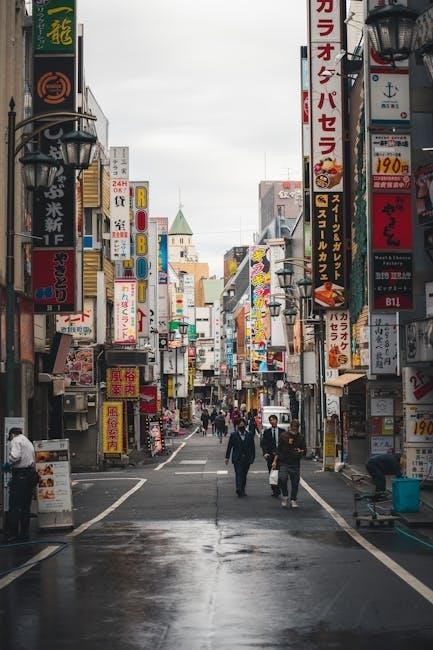
Road Safety in Italy
Italy prioritizes road safety through strict enforcement of traffic laws, public awareness campaigns, and continuous improvement of road infrastructure. Stricter speed limits, mandatory seat belt use, and lower alcohol limits contribute to reducing accidents, ensuring safer roads for all users.
7.1 Overview
Italy places a strong emphasis on road safety, with a comprehensive system of traffic signs and regulations designed to minimize accidents and ensure smooth traffic flow. The country has implemented various measures, including strict enforcement of speed limits, mandatory seatbelt use, and public awareness campaigns, to promote safe driving practices. Italian traffic signs, as detailed in the official PDF, play a crucial role in guiding drivers and pedestrians, helping to prevent collisions and reduce congestion. Over the years, Italy has seen improvements in road safety statistics, attributed to better infrastructure, education, and adherence to traffic rules. The government continues to prioritize road safety initiatives, ensuring that Italy’s roads remain safe for all users. These efforts highlight the importance of understanding and complying with Italian traffic signs to contribute to overall road safety.
7.2 Importance of Signs
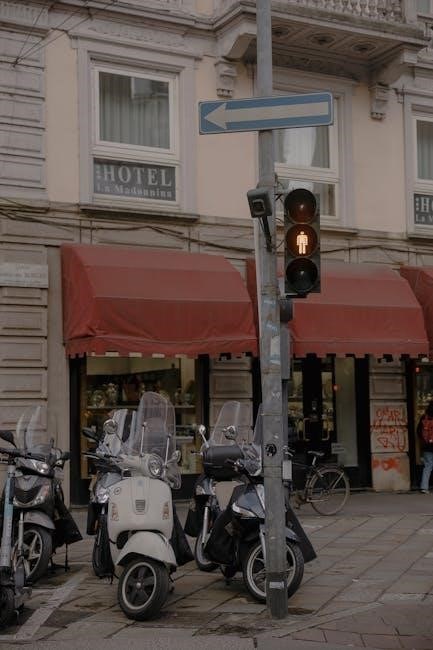
Italian traffic signs are essential for maintaining order and safety on the roads. They provide clear instructions and warnings to drivers, pedestrians, and cyclists, ensuring everyone understands their responsibilities and can navigate safely. The signs are designed to be universally understood, using standardized symbols and colors to convey messages quickly and effectively. By adhering to these signs, road users can avoid accidents, reduce congestion, and comply with legal requirements. The official Italian traffic signs PDF highlights the importance of these signs in promoting a culture of safety and respect among all road users. Understanding and obeying traffic signs is not only a legal obligation but also a critical component of responsible driving. Their presence ensures that Italy’s roads remain safe and efficient for everyone.